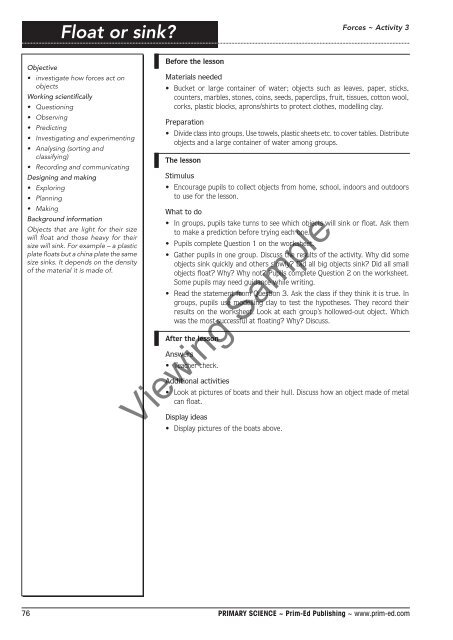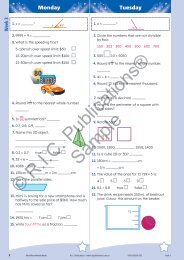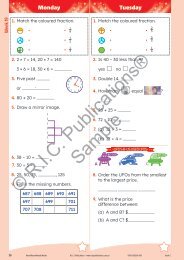PR-0552UK Primary Science - Book 2
Create successful ePaper yourself
Turn your PDF publications into a flip-book with our unique Google optimized e-Paper software.
Float or sink?<br />
Forces ~ Activity 3<br />
Objective<br />
• investigate how forces act on<br />
objects<br />
Working scientifically<br />
• Questioning<br />
• Observing<br />
• Predicting<br />
• Investigating and experimenting<br />
• Analysing (sorting and<br />
classifying)<br />
• Recording and communicating<br />
Designing and making<br />
• Exploring<br />
• Planning<br />
• Making<br />
Background information<br />
Objects that are light for their size<br />
will float and those heavy for their<br />
size will sink. For example – a plastic<br />
plate floats but a china plate the same<br />
size sinks. It depends on the density<br />
of the material it is made of.<br />
Before the lesson<br />
Materials needed<br />
• Bucket or large container of water; objects such as leaves, paper, sticks,<br />
counters, marbles, stones, coins, seeds, paperclips, fruit, tissues, cotton wool,<br />
corks, plastic blocks, aprons/shirts to protect clothes, modelling clay.<br />
Preparation<br />
• Divide class into groups. Use towels, plastic sheets etc. to cover tables. Distribute<br />
objects and a large container of water among groups.<br />
The lesson<br />
Stimulus<br />
• Encourage pupils to collect objects from home, school, indoors and outdoors<br />
to use for the lesson.<br />
What to do<br />
• In groups, pupils take turns to see which objects will sink or float. Ask them<br />
to make a prediction before trying each one.<br />
• Pupils complete Question 1 on the worksheet.<br />
• Gather pupils in one group. Discuss the results of the activity. Why did some<br />
objects sink quickly and others slowly? Did all big objects sink? Did all small<br />
objects float? Why? Why not? Pupils complete Question 2 on the worksheet.<br />
Some pupils may need guidance while writing.<br />
• Read the statement from Question 3. Ask the class if they think it is true. In<br />
groups, pupils use modelling clay to test the hypotheses. They record their<br />
results on the worksheet. Look at each group’s hollowed-out object. Which<br />
was the most successful at floating? Why? Discuss.<br />
After the lesson<br />
Answers<br />
• Teacher check.<br />
Additional activities<br />
• Look at pictures of boats and their hull. Discuss how an object made of metal<br />
can float.<br />
Viewing Sample<br />
Display ideas<br />
• Display pictures of the boats above.<br />
76 <strong>PR</strong>IMARY SCIENCE ~ Prim-Ed Publishing ~ www.prim-ed.com


















